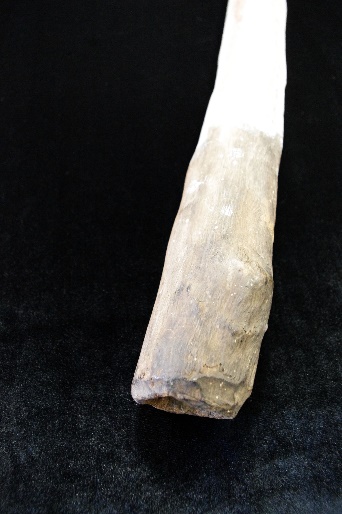Clapsticks
Download

Bilma (clapsticks), c. 1850–1955
ironwood
40.0 × 4.4 cm × 2.2 cm
38.2 × 3.5 × 1.8 cm
Gift of Professor Robert Illing
Rare Music Collection
University of Melbourne Library

Rare Music Collection, University of Melbourne Library
This pair of clapsticks was made by an unknown Indigenous artist in the Northern Territory, in the period after European settlement. The larger stick would have been held in one hand, the smaller stick in the other hand being tapped against it sharply. Carved by hand from a very hard, dense timber known as Cooktown ironwood, they have no decoration. At the ends are cut marks (made by a chiselling action with a metal tool), while the long surfaces have been smoothed.
Some clapsticks are higly decorated with wood-burned designs, or painted, and the choice of decoration depends on the maker and the particular purpose of the sticks.
Clapsticks – which in some regions are called bilma or bimla – are a traditional percussive instrument used by men and women in all Indigenous Australian communities, usually to maintain rhythmn during vocal chants. They are used in ceremonies and social dancing, and may accompany other instruments such as the didjeridu. Like many Indigenous objects, they can serve more than one purpose, such as for digging in the earth, or as trade items.
This pair was previously owned by Robert Illing (b. 1917), an Adelaide-based musicologist interested in early Baroque music, who was given them while visiting the Northern Territory in the 1950s.
Teaching ideas
The University of Melbourne’s curriculum is rich and varied, and changes from year to year. For more teaching ideas, contact a collection manager.
Aboriginal Cultural Studies
Study clapsticks as a commodity and a vehicle of Indigenous identity and resistance, to uncover the diverse and transitional nature of contemporary Aboriginal cultural production.
Aboriginalities
Use Indigenous art and artefacts in the university’s collections, such as the Rare Music Collection, to understand the complexity, challenges and richness of Australian Indigenous life and cultures.
Musics of the World
Study the music of Indigenous Australia – in its traditional and contemporary contexts – to understand the role of music in the lives of people outside the Western art music tradition.
Respect
Explore issues relating to context, disruption, authenticity, legal standing, development, reinvention, identity and minority status, in the preservation of Indigenous cultural material. Understand the importance of material culture in people’s lives.
Art and Indigenous Voice
Focus on connection to country and place by studying Indigenous art and artefacts in the university’s collections. Analyse, discuss and evaluate Indigenous culture, history, cultural safety, art and resistance – pre-contact, post-contact and now.
Historicising the Colonial Mythscape
Engage with Indigenous cultural materials to understand the intersection of archival, political and literary documentation in disclosing new perspectives on key historical events relevant to themes of national amnesia, memory and memorials.
Australian Indigenous Education
Develop a strategy for working with Australian Indigenous children and their families in school and other contexts, and protocols for working with Indigenous groups and communities with music, art and objects.
Encounters: Indigenous Peoples and Law
Study contact and contest between Indigenous people and settler colonisers represented by Australian objects held in the University of Melbourne, in the context of law.
Critical Debates in Indigenous Studies
Use Indigenous music to explore vocational possibilities in Australian Indigenous affairs, to develop and communicate a mature and broad intellectual perspective on Australian Indigenous affairs.
Intersecting objects
-

Unknown maker (Australian, Gunditjmara)
Bilma (clapsticks)
wood
42.0 × 6.0 cm
43.0 × 5.6 cm
Grainger Museum
University of Melbourne
00.0211 -

Unkown maker (Australian)
Yidaki or didjeridu, c. 1940 (detail)
wood, clay, ochre
129.0 × 5.0 cm (approx. diameter)
Grainger Museum
University of Melbourne
00.0210
To learn more, visit the Rare Music Collection and Grainger Museum websites.
References
Amanda Harris (ed.), Circulating cultures: Exchanges of Australian Indigenous music, dance and media, Canberra: ANU Press, 2014.
Keeping scores: 100 years of the music library (exhibition catalogue), University of Melbourne Library, 2008.